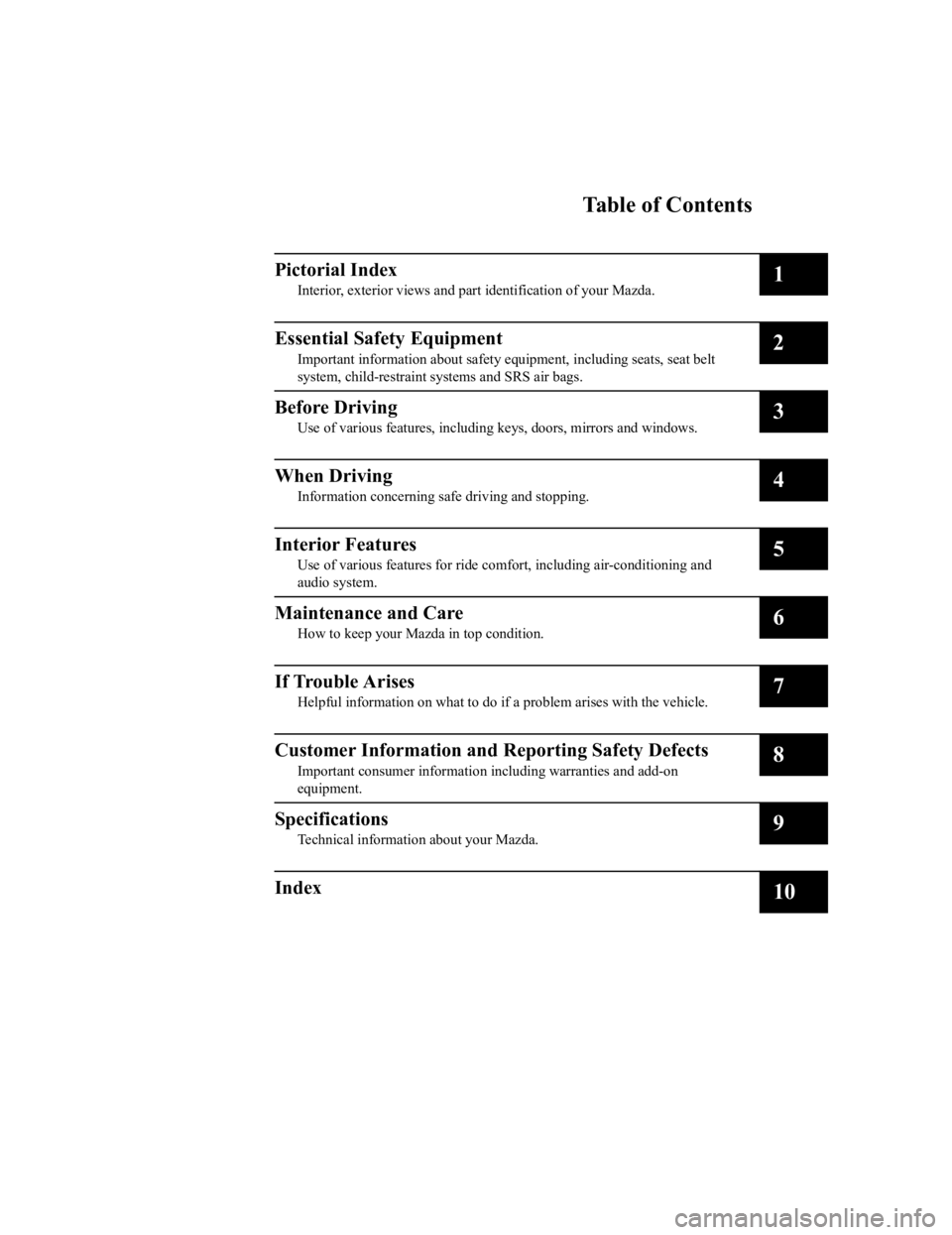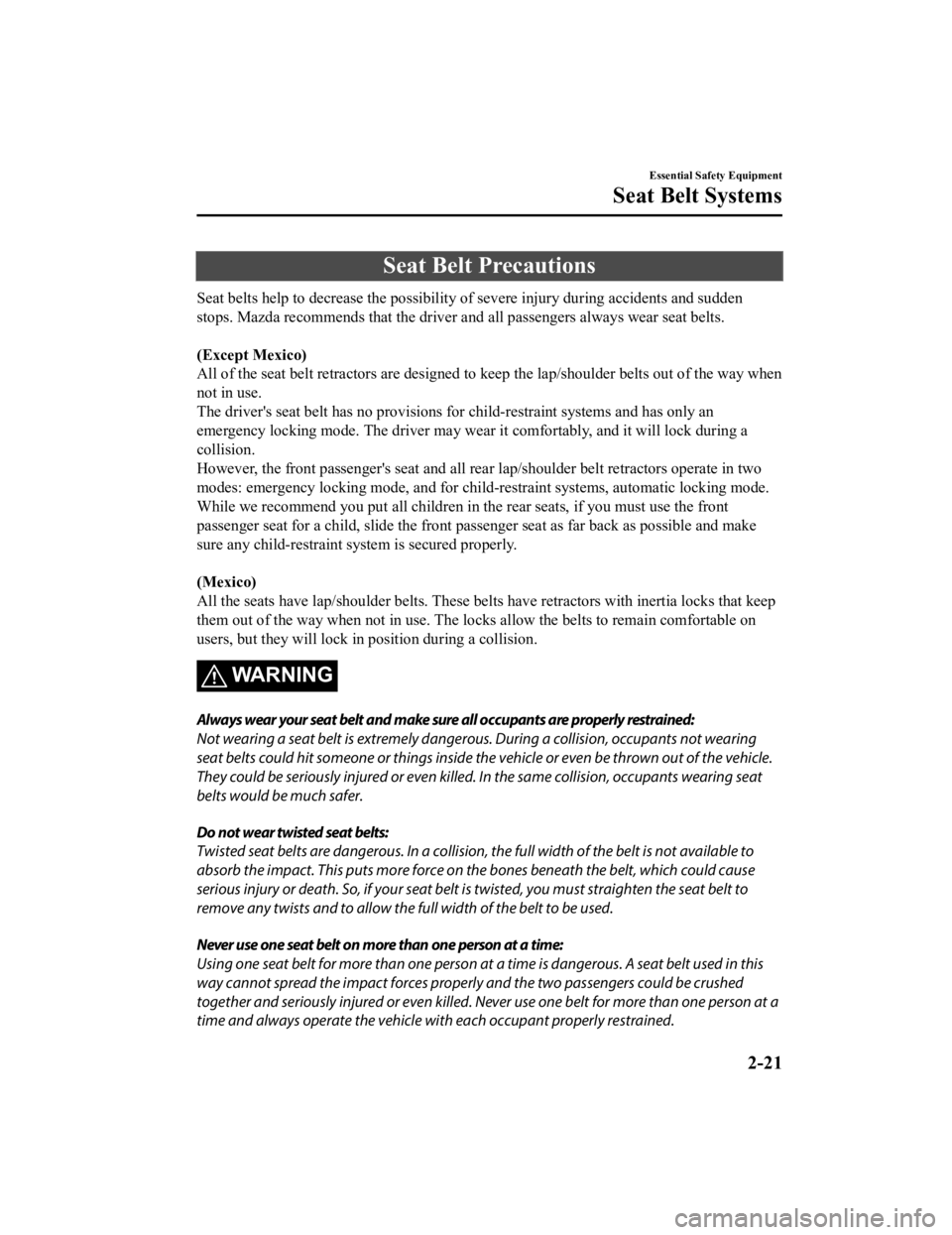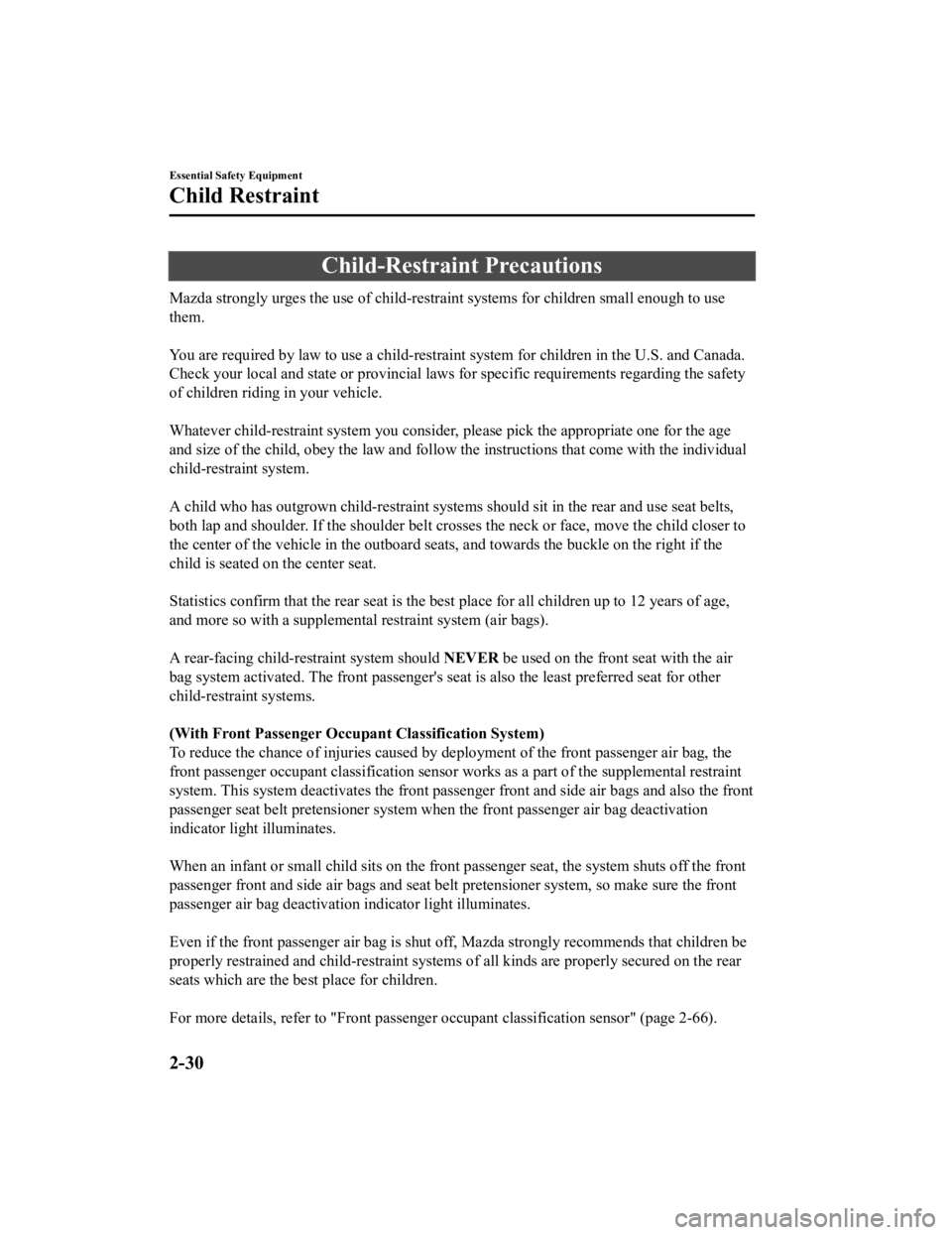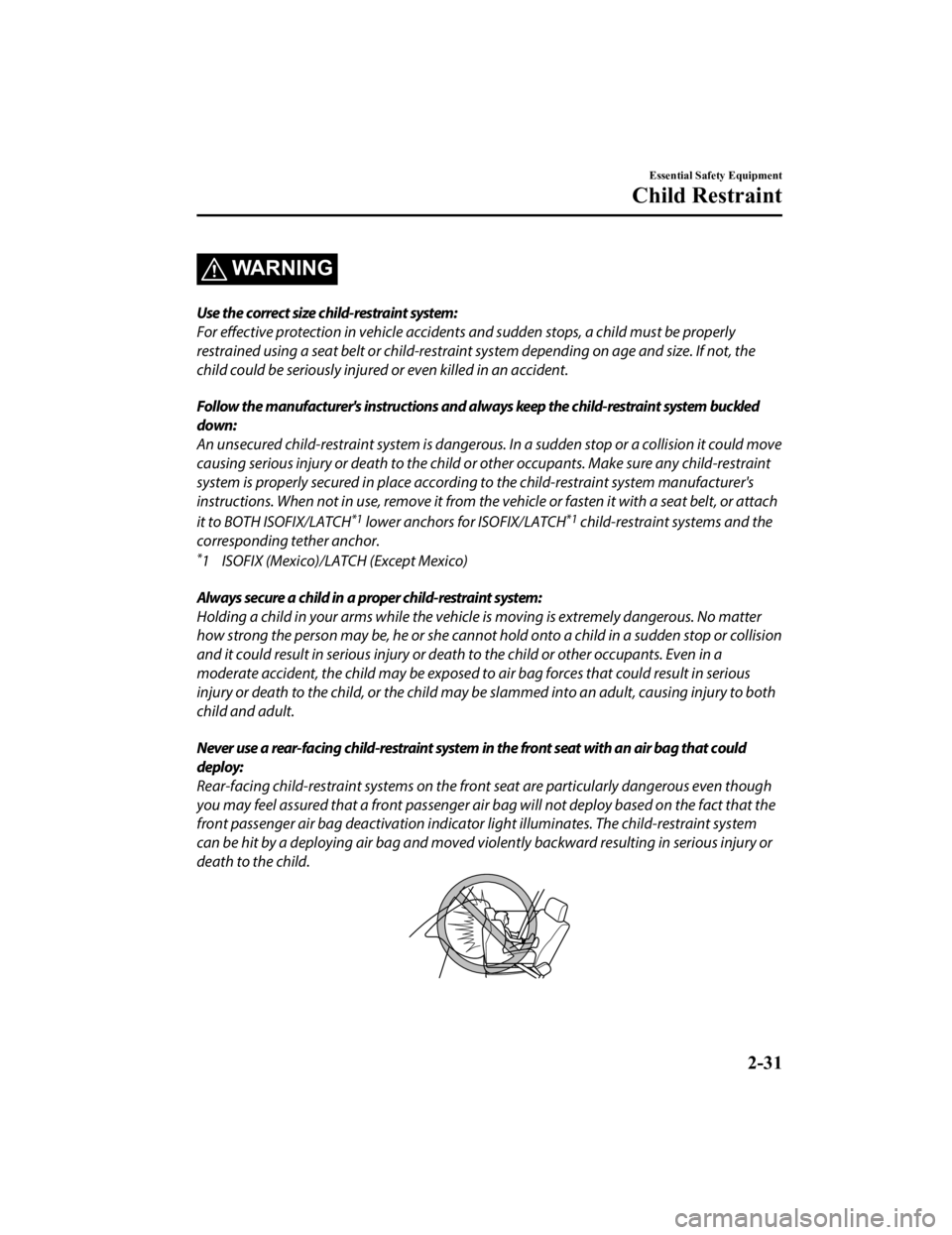child restraint MAZDA MODEL CX-3 2021 Owners Manual
[x] Cancel search | Manufacturer: MAZDA, Model Year: 2021, Model line: MODEL CX-3, Model: MAZDA MODEL CX-3 2021Pages: 618, PDF Size: 64.58 MB
Page 5 of 618

Table of Contents
Pictorial Index
Interior, exterior views and part identification of your Mazda.1
Essential Safety Equipment
Important information about safety e quipment, including seats, seat belt
system, child-restraint systems and SRS air bags.2
Before Driving
Use of various features, including keys, doors, mirrors and windows.3
When Driving
Information concerning safe driving and stopping.4
Interior Features
Use of various features for ride comfort, including air-conditioning and
audio system.5
Maintenance and Care
How to keep your Mazda in top condition.6
If Trouble Arises
Helpful information on what to do if a problem arises with the vehicle.7
Customer Information and Reporting Safety Defects
Important consumer informati on including warranties and add-on
equipment.8
Specifications
Technical information about your Mazda.9
Index10
CX-3_8JL1-EA-20G_Edition1_old 2020-5-22 15:31:00
Page 13 of 618

2Essential Safety Equipment
Important information about safety equipment, including seats, seat
belt system, child-restraint systems and SRS air bags.
Seats.................................................... 2-2 Seat Precautions............................2-2
Front Seat......................................2-5
Rear Seat.....................................2-14
Head Restraints...........................2-17
Seat Warmer/Heated Steering
Wheel................................................ 2-19 Seat Warmer
*.............................. 2-19
Heated Steering Wheel
*............. 2-20
Seat Belt Systems.. ........................... 2-21
Seat Belt Precautions.................. 2-21
Seat Belt......................................2-24
Seat Belt Warning Systems.........2-25
Front Seat Belt Pretensioner and
Load Limiting Systems...............2-26
Seat Belt Extender...................... 2-28
Child Restraint................................ 2-30 Child-Restraint Precautions........ 2-30
Child-Restraint System
Installation.................................. 2-35
Child-Restraint Sy stem Suitability
for Various Seat Positions
Table........................................... 2-37
Installing Child-Restraint
Systems....................................... 2-40
SRS Air Bags....................................2-51 Supplemental Restraint System
(SRS) Precautions.......................2-51
Supplemental Restraint System
Components................................ 2-57
How the SRS Air Bags Work..... 2-59
SRS Air Bag Deployment
Criteria........................................ 2-63
Limitations to SRS Air Bag........2-64
Front Passenger Occupant
Classification System
*................2-66
Constant Monitoring...................2-70
*Some models.2-1
CX-3_8JL1-EA-20G_Edition1_old 2020-5-22 15:31:00
Page 14 of 618

Seat Precautions
WA R N I N G
Make sure the adjustable components of a seat are locked in place:
Adjustable seats and seatbacks that are not securely locked are dangerous. In a sudden stop
or collision, the seat or seatback could move, causing injury. Make sure the adjustable
components of the seat are locked in place by attempting to slide the seat forward and
backward and rocking the seatback.
Never allow children to adjust a seat:
Allowing children to adjust a seat is dangerous as it could result in serious injury if a child's
hands or feet become caught in the seat.
Do not drive with the seatback unlocked:
All of the seatbacks play an important role in your protection in a vehicle. Leaving the
seatback unlocked is dangerous as it can a llow passengers to be ejected or thrown around
and baggage to strike occupants in a sudden stop or collision, resulting in severe injury. After
adjusting the seatback at any time, even when there are no other passengers, rock the
seatback to make sure it is locked in place.
Adjust a seat only when the vehicle is stopped:
If the seat is adjusted while the vehicle is being driven, the seating posture may become
unstable and the seat could move unexpectedly resulting in injury.
Do not modify or replace the front seats:
Modifying or replacing the front seats such as replacing the upholstery or loosening any bolts
is dangerous. The front seats contain air bag components essential to the supplemental
restraint system. Such modifications could damage the supplemental restraint system and
result in serious injury. Consult an Authorized Mazda Dealer if there is any need to remove or
reinstall the front seats.
Do not drive with damaged front seats:
Driving with damaged front seats, such as se at cushions torn or damaged down to the
urethane, is dangerous. A collision, even one no t strong enough to inflate the air bags, could
damage the front seats which contain essential air bag components. If there was a
subsequent collision, an air bag may not deploy which could lead to injuries. Always have an
Authorized Mazda Dealer inspect the front seats, front seat belt pretensioners and air bags
after a collision.
Essential Safety Equipment
Seats
2-2
CX-3_8JL1-EA-20G_Edition1_old 2020-5-22 15:31:00
Page 15 of 618

Do not drive with either front seats reclined:
Sitting in a reclined position while the vehicle is moving is dangerous because you do not get
the full protection from seat belts. During sudden braking or a collision, you can slide under
the lap belt and suffer serious internal injuri es. For maximum protection, sit well back and
upright.
Do not place an object such as a cushion between the seatback and your back:
Putting an object such as a cushion between the seatback and your back is dangerous
because you will be unable to maintain a safe driving posture and the seat belt cannot
function at its full capacity in a collision, wh ich could result in a serious accident, injury or
death.
Do not place objects under the seat:
The object could get stuck and cause the seat to not be fixed securely, and result in an
accident.
Do not stack cargo higher than the seatbacks:
Stacking luggage or other cargo higher than the seatbacks is dangerous. During sudden
braking or a collision, objects can fly around and become projectiles that may hit and injure
passengers.
Make sure luggage and cargo is secured before driving:
Not securing cargo while driving is dangerous as it could move or be crushed during sudden
braking or a collision and cause injury.
Never allow a passenger to sit or stand on the folded seatback while the vehicle is moving:
Driving with a passenger on the folded seatback is dangerous. Allowing a child to sit up on
the folded seatback while the vehicle is moving is particularly dangerous. In a sudden stop or
even a minor collision, a child not in a proper seat or child-restraint system and seat belt could
be thrown forward, back or even out of the vehi cle resulting in serious injuries or death. The
child in the baggage area could be thrown into other occupants and cause serious injury.
CAUTION
When operating a seat, be careful not to put yo ur hands or fingers near the moving parts of
the seat or on the side trim to prevent injury.
When moving the seats, make sure there is no cargo in the surrounding area. If the cargo
gets caught it could damage the cargo.
(Manual Seat)
Essential Safety Equipment
Seats
2-3
CX-3_8JL1-EA-20G_Edition1_old 2020-5-22 15:31:00
Page 26 of 618

Rear Seat
▼Split Folding the Seatbacks
By lowering the rear seatbacks the luggage
compartment space can be expanded.
WA R N I N G
Do not drive the vehicle with occupants on
folded down seatbacks or in the luggage
compartment.
Putting occupants in the luggage
compartment is dangerous because seat
belts cannot be fastened which could lead
to serious injury or death during sudden
braking or a collision.
Do not allow children to play inside the
vehicle with the seatbacks lowered.
Allowing children to play in the vehicle
with the seatbacks folded down is
dangerous. If a child enters the luggage
compartment and the seatbacks were
raised back up, the child may become
trapped in the luggage compartment
which could lead to an accident.
Tightly secure cargo in the luggage
compartment when it is transported with
the seatbacks folded down.
Driving without tightly securing cargo and
luggage is dangerous as it could move and
become an obstruction to driving during
emergency braking or
a collision resulting
in an unexpected accident.
When transporting cargo, do not allow the
cargo to exceed the height of the
seatbacks.
Transporting cargo stacked higher than
the seatbacks is dangerous as visibility to
the rear and sides of the vehicle is reduced
which could interfere with driving
operations and lead to an accident.
Lowering the seatbacks
CAUTION
When folding the seatback forward,
always support the seatback with your
hand. If it is not supported by a hand,
fingers or the hand pressing the push
knob could be injured.
Check the position of a front seat before
folding a rear seatback.
Depending on the position of a front
seat, it may not be possible to fold a rear
seatback all the way down because it
may hit the seatback of the front seat
which could scratch or damage the front
seat or its pocket. Remove the head
restraint on the rear outboard seat if
necessary.
(Vehicles with rear armrest)
Before folding a rear seatback, make sure
that the armrest is stored. If a seatback is
lowered without storing the armrest, it
could deform, damage, or scratch the
armrest.
1. Lower the head restraint all the way down.
Refer to Head Restraints on page
2-17.
Essential Safety Equipment
Seats
2-14
CX-3_8JL1-EA-20G_Edition1_old 2020-5-22 15:31:00
Page 33 of 618

Seat Belt Precautions
Seat belts help to decrease the possibility of severe injury during accidents and sudden
stops. Mazda recommends that the driver and all passengers always wear seat belts.
(Except Mexico)
All of the seat belt retractors are designed to keep the lap/shoulder belts out of the way when
not in use.
The driver's seat belt has no provisions for child-restraint systems and has only an
emergency locking mode. The driver may wear it comfortably, and it will lock during a
collision.
However, the front passenger's seat and all re ar lap/shoulder belt retractors operate in two
modes: emergency locking mode, and for child-restraint systems, automatic locking mode.
While we recommend you put all children in the rear seats, if you must use the front
passenger seat for a child, slide the front passenger seat as far back as possible and make
sure any child-restraint system is secured properly.
(Mexico)
All the seats have lap/shoulder belts. These belts have retractors with inertia locks that keep
them out of the way when not in use. The lo cks allow the belts to remain comfortable on
users, but they will lock in position during a collision.
WARNING
Always wear your seat belt and make sure all occupants are properly restrained:
Not wearing a seat belt is extremely dangerou s. During a collision, occupants not wearing
seat belts could hit someone or things inside the vehicle or even be thrown out of the vehicle.
They could be seriously injured or even killed. In the same collision, occupants wearing seat
belts would be much safer.
Do not wear twisted seat belts:
Twisted seat belts are dangerous. In a collision, the full width of the belt is not available to
absorb the impact. This puts more force on the bones beneath the belt, which could cause
serious injury or death. So, if your seat belt is twisted, you must straighten the seat belt to
remove any twists and to allow the fu ll width of the belt to be used.
Never use one seat belt on more than one person at a time:
Using one seat belt for more than one person at a time is dangerous. A seat belt used in this
way cannot spread the impact forces properly and the two passengers could be crushed
together and seriously injured or even killed. Ne ver use one belt for more than one person at a
time and always operate the vehicle wi th each occupant properly restrained.
Essential Safety Equipment
Seat Belt Systems
2-21
CX-3_8JL1-EA-20G_Edition1_old 2020-5-22 15:31:00
Page 35 of 618

The shoulder belt should be worn across your shoulder properly, but never across the
stomach area.
Persons with serious medical conditions also should wear seat belts. Check with your doctor
for any special instructions regarding specific medical conditions.
▼Emergency Locking Mode
When the seat belt is fastened, it will
always be in the emergency locking mode.
In the emergency locking mode , the belt remains comfortable on the occupant and the
retractor will lock in position during a collision.
If the belt is locked and cannot be pulled out, retract the belt once, and then try pulling it out
slowly. If this fails, pull the belt strongly 1 time and loosen, then pull it out again slowly.
(Seat Belt with Auto matic Locking Mode)
When the seat belt is fastened, it will always be in the emergency locking mode until it is
switched to automatic locking mode by pulling it all the way out to its full length. If the belt
feels tight and hinders comfortable movement while the vehicle is stopped or in motion, it
may be in the automatic locking mode because the belt has been pulled too far out. To return
the belt to the more comfortable emergency lo cking mode, wait until the vehicle has stopped
in a safe, level area, retract the belt fully to convert it back to emergency locking mode and
then extend it around you again.
▼ Automatic Locking Mode*
Always use the automatic locking mode to keep
the child-restraint system from shifting to
an unsafe position in the event of an accident. To enable seat belt automatic locking mode,
pull it all the way out and connect it as instructed on the child-restraint system. It will retract
down to the child-restra int system and stay locked on it. See the section on child restraint
(page 2-30).
Essential Safety Equipment
Seat Belt Systems
*Some models.2-23
CX-3_8JL1-EA-20G_Edition1_old 2020-5-22 15:31:00
Page 41 of 618

Do not leave a seat belt extender
connected to the buckle:
Leaving a seat belt extender connected to
the buckle without using the seat belt is
dangerous. When the seat belt extender is
connected to the driver's seat belt buckle
(or front passenger's seat belt buckle), the
SRS driver's (or front passenger's) air bag
system will determine that the driver (or
front passenger) is wearing the seat belt
even if the driver (or front passenger) is not
wearing it. This condition could cause the
driver's (or front passenger's) air bag to not
activate correctly and result in death or
serious injury in the event of collision.
Always wear the seat belt with the seat belt
extender.
Do not use the seat belt extender when
installing a child-restraint system on the
front or rear passenger seat:
Using a seat belt extender to fasten a
child-restraint system on any seat is
dangerous. Always follow the
child-restraint system manufacturer's
installation instructions and never use a
seat belt extender.
NOTE
When not in use, remove the seat belt
extender and store it in the vehicle. If the
seat belt extender is left connected, the
seat belt extender might get damaged as it
will not retract with the rest of the seat belt
and can easily fall out of the door when
not in use and be damaged. In addition,
the seat belt warning light will not
illuminate and function properly.
Essential Safety Equipment
Seat Belt Systems
2-29
CX-3_8JL1-EA-20G_Edition1_old2020-5-22 15:31:00
Page 42 of 618

Child-Restraint Precautions
Mazda strongly urges the use of child-restraint systems for children small enough to use
them.
You are required by law to use a child-restraint system for children in the U.S. and Canada.
Check your local and state or provincial laws for specific requirements regarding the safety
of children riding in your vehicle.
Whatever child-restraint system you consider, please pick the appropriate one for the age
and size of the child, obey the law and follow th e instructions that come with the individual
child-restraint system.
A child who has outgrown child-restraint systems should sit in the rear and use seat belts,
both lap and shoulder. If the shoulder belt crosses the neck or face, move the child closer to
the center of the vehicle in the outboard seats, and towards the buckle on the right if the
child is seated on the center seat.
Statistics confirm that the rear seat is the best place for all children up to 12 years of age,
and more so with a supplement al restraint system (air bags).
A rear-facing child-restraint system should NEVER be used on the front seat with the air
bag system activated. The front passenger's seat is also the least preferred seat for other
child-restraint systems.
(With Front Passenger Occupa nt Classification System)
To reduce the chance of injuries caused by de ployment of the front passenger air bag, the
front passenger occupant classification sensor works as a part of the supplemental restraint
system. This system deactivates the front passe nger front and side air bags and also the front
passenger seat belt pretensioner system when the front passenger air bag deactivation
indicator light illuminates.
When an infant or small child sits on the front passenger seat, the system shuts off the front
passenger front and side air bags and seat belt pretensioner system, so make sure the front
passenger air bag deactivation indicator light illuminates.
Even if the front passenger air bag is shut of f, Mazda strongly recommends that children be
properly restrained and child-restraint systems of all kinds are properly secured on the rear
seats which are the best place for children.
For more details, refer to "Front passenge r occupant classification sensor" (page 2-66).
Essential Safety Equipment
Child Restraint
2-30
CX-3_8JL1-EA-20G_Edition1_old 2020-5-22 15:31:00
Page 43 of 618

WARNING
Use the correct size child-restraint system:
For effective protection in vehicle accidents and sudden stop s, a child must be properly
restrained using a seat belt or child-restraint system depending on age and size. If not, the
child could be seriously injured or even killed in an accident.
Follow the manufacturer's instructions and always keep the child-restraint system buckled
down:
An unsecured child-restraint system is dangerous . In a sudden stop or a collision it could move
causing serious injury or death to the child or other occupants. Make sure any child-restraint
system is properly secured in place accordin g to the child-restraint system manufacturer's
instructions. When not in use, remove it from the vehicle or fasten it with a seat belt, or attach
it to BOTH ISOFIX/LATCH
*1 lower anchors for ISOFIX/LATCH*1 child-restraint systems and the
corresponding tether anchor.
*1 ISOFIX (Mexico)/LATCH (Except Mexico)
Always secure a child in a proper child-restraint system:
Holding a child in your arms while the vehicl e is moving is extremely dangerous. No matter
how strong the person may be, he or she cannot hold onto a child in a sudden stop or collision
and it could result in serious injury or death to the child or other occupants. Even in a
moderate accident, the child may be exposed to air bag forces that could result in serious
injury or death to the child, or the child may be slammed into an adult, causing injury to both
child and adult.
Never use a rear-facing child-restraint system in the front seat with an air bag that could
deploy:
Rear-facing child-restraint systems on the front seat are particularly dangerous even though
you may feel assured that a front passenger air bag will not deploy based on the fact that the
front passenger air bag deactivation indicato r light illuminates. The child-restraint system
can be hit by a deploying air bag and moved viol ently backward resulting in serious injury or
death to the child.
Essential Safety Equipment
Child Restraint
2-31
CX-3_8JL1-EA-20G_Edition1_old 2020-5-22 15:31:00